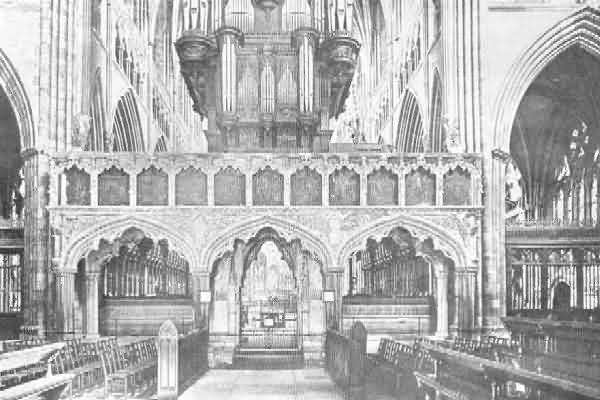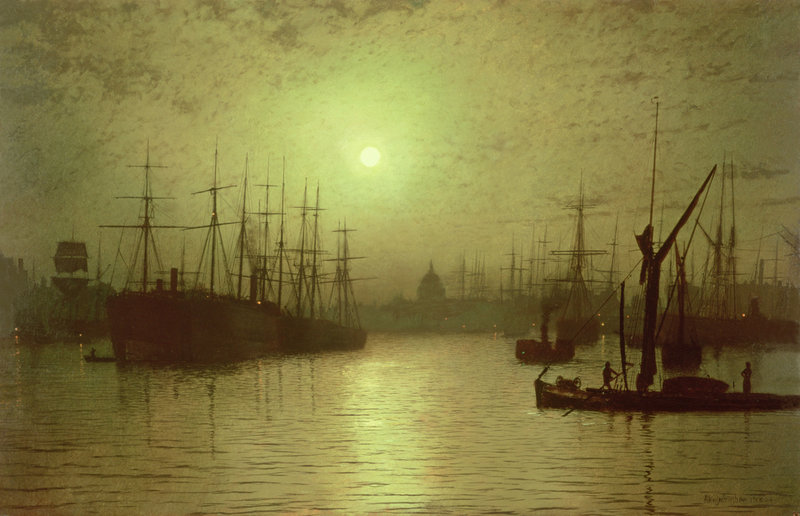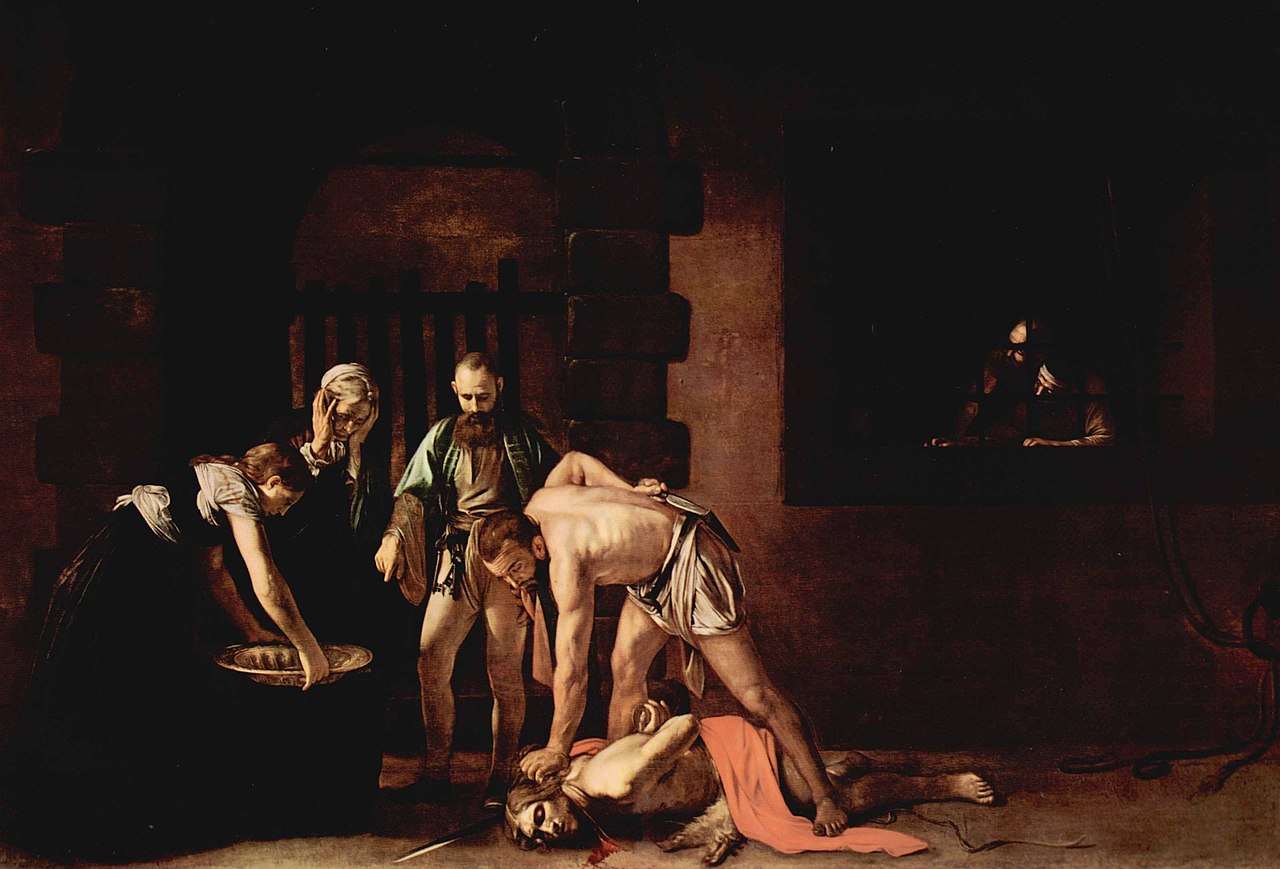Text from Wikipedia - the free encyclopaedia,
unless otherwise stated.

Rood Screen,
Saint Birinus' Church,
Dorchester-on-Thames,
Oxfordshire, England.
Illustration: PINTEREST

Rood Screen in
Saint Mary's Church,
Staunton-in-the-Vale,
Nottinghamshire, England.
Photo: 22 June 2013.
Source: Own work.
Author: Andrewrabbott.
(Wikimedia Commons)
Domesday Book records a Church and a Priest in Staunton, then called 'Stanton',
but which afterwards has been called Staunton-in-the-Vale or simply 'Staunton'.
Between Nave and Chancel is a Rood Screen from 1519.
This Text from

The Rood Screen,
Saint Giles' Church,
Cheadle, Staffordshire, England.
Designed by Augustus Welby Northmore Pugin, between 1841-1846,
and financed by John Talbot, the 16th Earl of Shrewsbury. Augustus Pugin
endeavoured to create "a perfect revival of an English Parish Church
of the time of King Edward I".
Illustration: NEW LITURGICAL MOVEMENT
The Rood Screen (also Choir Screen, Chancel Screen, or Jubé (French)) is a very common feature in Late-Mediaeval Church architecture. It is typically an ornate Partition between the Chancel and Nave, of, more-or-less, open Tracery, constructed of wood, stone, or wrought iron. The Rood Screen would originally have been surmounted by a Rood Loft, carrying The Great Rood, a sculptural representation of The Crucifixion.
In English, Scottish, and Welsh Cathedral, Monastic, and Collegiate Churches, there were, commonly, two Transverse Screens, with a Rood Screen, or Rood Beam, located one Bay West of The Pulpitum Screen, but this double arrangement nowhere survives complete, and, accordingly, the preserved Pulpitum in such Churches is sometimes referred to as a Rood Screen. At Wells Cathedral, the Mediaeval arrangement was restored in the 20th-Century, with the Mediaeval "Strainer Arch" supporting a Rood, placed in front of The Pulpitum Screen and Organ.

photographed in the Early-20th-Century, The Interior of The Pulpitum Screen was opened up
in a 19th-Century reconstruction, so as to provide worshippers with a view of The High Altar. Originally it was solid.
Original publication: Stabb, John. Some Old Devon Churches, Their Rood Screens, Pulpits,
Fonts, etc (Simpkin, Marshall, Hamilton, Kent and Co, London, Vol I, 1908). Frontispiece.
URL: http://www.wissensdrang.com/stabb000.htm (maintained by Roger Peters).
Author: John Stabb, photographer (1865-1917).
(Wikimedia Commons)
Rood Screens can be found in Churches in many parts of Europe: The German word for a Rood Screen is Lettner; the French word is Jubé; the Italian word is Tramezzo; and the Dutch word is Doksaal. However, in Catholic Countries, they were generally removed during The Counter-Reformation, when the retention of any visual barrier between The Laity and The High Altar was widely seen as inconsistent with the Decrees of The Council of Trent. Accordingly, Rood Screens now survive in much greater numbers in Anglican and Lutheran Churches; with the greatest number of survivals, complete with Screen and Rood figures, in Scandinavia. The iconostasis in Eastern Christian Churches is a visually similar barrier, but is now generally considered to have a different origin, deriving from the ancient Altar Screen or Templon.
Five-Panel Deësis (Centre).
Iconostasis in the Cathedral of The Annunciation,
Moscow Kremlin, Russia, by Theophanes the Greek, 1405.
This File: 6 February 2005.
User: .:Ajvol:
(Wikimedia Commons)
The word "Rood" is derived from the Saxon word "Rood" or "Rode", meaning "Cross". The Rood Screen is so called because it was surmounted by The Rood, itself, a large figure of The Crucified Christ. Commonly, to either side of The Rood, there stood supporting statues of Saints, normally Mary and Saint John the Apostle, in an arrangement comparable to The Deesis, always found in the centre of an Orthodox Iconostasis (which uses Saint John the Baptist, instead of John the Apostle, and a Pantokrator, instead of a Crucifixion).

The carved Pulpitum Screen,
Southwell Minster,
Nottinghamshire,
England.
Photo: 25 October 2005.
Source: Own work.
Author: Necrothesp.
(Wikimedia Commons)
Latterly, in England and Wales, The Rood tended to rise above a narrow Loft (called "The Rood Loft"), which could occasionally be substantial enough to be used as a Singing Gallery (and might even contain an Altar). However, the main purpose was to hold Candles to light The Rood, itself. The panels and uprights of The Screen did not support The Loft, which, instead, rested on a substantial Transverse Beam called "The Rood Beam" or "Candle Beam".
Access to The Rood Loft was via a narrow Rood Stair, set into the Piers supporting The Chancel Arch. In Parish Churches, the space between The Rood Beam and The Chancel Arch was commonly filled by a boarded, or lath and plaster, Tympanum, set immediately behind The Rood figures and painted with a representation of The Last Judgement. The Roof Panels, of The First Bay of The Nave, were commonly richly decorated to form a Celure, or Canopy of Honour, or there might be a separate Celure Canopy attached to the front of The Chancel Arch.
The carving or construction of The Rood Screen often included Lattice-Work, which makes it possible to partially see through The Screen, from The Nave into The Chancel. The term "Chancel" derives from the Latin word "Cancelli", meaning "Lattice", a term which had long been applied to the low Metal-Work or Stone Screens that delineate The Choir Enclosure in Early-Mediaeval Italian Cathedrals and major Churches. The passage through The Rood Screen was fitted with doors, which were kept locked, except during Services.

The Rood Screen,
now in The Lady Chapel,
Shrine of Saint Augustine,
Ramsgate, Kent, England.
Photographer: Nicholas Callinan.
Illustration:
A Rood Screen in an Anglican Parish Church. The 15th-Century Rood Screen of
Saint Mellanus, Mullion, Cornwall, England, was restored, with Rood Figures and Rood Loft,
by F. C. Eden in 1925.
Photo: 6 December 2007.
Source: Own work.
Author: Mattana.
(Wikimedia Commons)

The Rood,
above The Rood Screen,
with The Rood Loft, behind.
The Church of Saint Mellanus,
Mullion, Cornwall, England
Photo: 6 December 2007.
Source: Own work.
Author: Mattana.
(Wikimedia Commons)
































